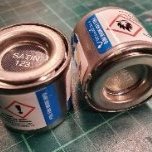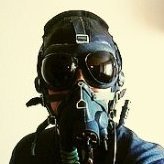-
Posts
7,528 -
Joined
-
Last visited
-
Days Won
54
TheBaron last won the day on July 27 2022
TheBaron had the most liked content!
About TheBaron
- Birthday 29/03/1965
Profile Information
-
Gender
Male
-
Location
West of the Meridian
-
Interests
Oddity, perversity, disparity.
TheBaron's Achievements

Completely Obsessed Member (6/9)
33.8k
Reputation
-

Westland Wasp HAS 1: 'Ambuscade Flight: XT778'
TheBaron replied to TheBaron's topic in Work in Progress - Aircraft
Hi Pete! I'm not anticipating problems on either count tbh: I find polishing resin bucks with the Dremel and polishing compound produces a nice mirror-like finish whilst the buck walls themselves are thick enough to avoid structural integrity issues. That's a puzzler Ian. It looks as if the resin has failed to cure on portions of the right-hand object but this is not something I've encountered before. I know you use the Mars 4 - with which I'm unfamiliar as to any idiosyncracies - so all I can suggest in such a situation is a diagnostic to isolate whether the problem lies in the printer or the resin. In this regard I'd print identically-oriented parts with a different resin - something cheap like Elegoo's standard grey should suffice - to see if the same error recurs. If it doesn't, that would point toward a problem with that particular Siraya resin in relation to the printer, if it does, it would likely be a problem with ether the printer, or print settings. Apologies my friend if you've already done all that and I'm simply teaching my Dubai grandmother to suck eggs...- 763 replies
-
- 3
-

-

Westland Wasp HAS 1: 'Ambuscade Flight: XT778'
TheBaron replied to TheBaron's topic in Work in Progress - Aircraft
As it should be. Glad it's working out Pete!- 763 replies
-
- 1
-

-

Westland Wasp HAS 1: 'Ambuscade Flight: XT778'
TheBaron replied to TheBaron's topic in Work in Progress - Aircraft
Very kind of you as always G. Many thanks Bill: it's taken a while to get round to posting it up as I kept finding another flaw just at that point when you think you've caught them all. Gives you a whole new level of respect for those who have to do it on the real thing! Cheers T. I'd be lying if I didn't admit that - for reasons I'm not entirely sure myself - those carriers were a source of personal satisfaction. The various racks and carriers on period aircraft always draw my eye - possibly as there's something very Victorian-engineering about their structure that persisted into the modern era... Generous sentiments from you as always Chris - my thanks. Sincere thanks. It often - not out of any personal hubris - amazes me that we can make these kinds of things ourselves now. Being of a certain age I grew up with this kind of 'materializer' idea as a well-worn scifi trope. Thanks Colin. Yes, we're of a like mind on the glazing - vacforming is the tool of choice. I've the bucks designed: - but as it'll take a while to dial-in how much allowance to make for shrinkage and cross-section of the transparent material, am only in the early stages of test-printing the bucks for both scales: N.B to self: remember to write the reduction factor on each one. With regards to the roof windows - this is a downright frightening image: Actual operational incidents here, complete with an unorthodox submarine recovery procedure... https://hmsnaiad.co.uk/naiad_flight.html Gracious of you Kev. My thanks; and decent of you Neil to avoid appending 'of aberrant obsession' at the end of that sentence! Cheers Simon. It seems to be a universal law that the closer you get to the end of a project, the more it seems to slow down so that you think you'll never get there... 😁 Kind words and nice to feel missed Pete. Likewise fond felicitations to yourself. How's retirement treating ye? Cheers Ian. That's interesting about the nature of the problem with Siraya stuff: I've only used their purple and blue Tech Cast stuff for metal casting so no experience to draw upon with their ABS I'm afraid. Odd that the flaw exists between supports - could you post a picture of the issue? For the main parts like doors, torps etc. in the previous post I used Elegoo's 8K Space Grey resin: at a 3 micron layer height (and slightly under-exposed) the stuff gives beautifully crisp renditions of the CAD designs. For larger surface areas with sparser detail like the rear fuselage/boom assemblies I still use Elegoo's standard grey which I've been using for years. Anything printed in black is using eSun's hard Tough resin for extra strength. That's very kind of you to say so and I'm grateful. Cheers Dave. To end: reading about Hawkwind recently - only saw them once at the Hammersmith Odeon in the early 80's - but what is possibly the most-Hawkwind anecdote ever regarding one of their solstice gigs at Stonehenge during that period: (Source: The Saga of "Hawkwind", by Carol Clerk.)- 763 replies
-
- 8
-

-

Westland Wasp HAS 1: 'Ambuscade Flight: XT778'
TheBaron replied to TheBaron's topic in Work in Progress - Aircraft
1/6th of the way round the sun since the last update here and I'm shamelessly blaming interstellar debris as an excuse... (This - interestingly enough - from an issue of Flight magazine published in the early 50s.) Work on the Wasp has in fact been continuing in the background of the business of living in these times, so best to recount some of the key developments before what's happened and why get lost in the fog of the now. Essentially I've been gradually working my way through the plethora of parts which amassed in CAD form over the past few months and which were long-overdue for translation into solid objects. Due to the combination of extreme thin-ness and compound curves on things like doors and so forth, this required a lot of troubleshooting with resin types and orientations in order to maximize part strength and avoid striated surfaces due to poor orientation of such curvatures in space. It also took a lot of customization of support types in VDT, which I have to say has proven itself a godsend for the variety of shapes involved here in terms of facility. Here are the final results of all these various print runs en masse: And lest anyone gain a false impression that over time you ever get good enough for your efforts to succeed first time on more than a single part, this rarely rarely happens as the image below demonstrates in terms of the the level of failures required to iron out flaws and reach that point above: The usual caveat applies to the following images in that they are shown freshly printed i.e., resin washed off but none of the print-support stumps sanded from surfaces. The design of the rear wall of the cabin was revised in Fusion compared to the printed version shown here in previous updates, in that it now has the angled rear-window panels on either side of the central panel integrated into the one design: It turned out to be feasible in the end to print these as one component and will, I think, prove a more accurate solution than trying to glue them on separately at the right angle during assembly: All of that surface details remains present in the 1/32 version shown below as well, so my guesses about minimum feature size in the 1/24 version to survive scaling down seem to be holding up pretty consistently across the model so far: Pretty much the same for the doors; both front: - and rear: - retaining equal levels of detail when scaled down to 1/32: Door pillars too will look even nicer with the naviagtion lights installed later: Too fragile to reproduce in 8k resin, the sliding windows for pilot/obervers had their frames printed using eSun Hard Tough resin: Again the 1/32 version of these also survived the Alice in Wonderland treatment and printed as well. Amongst a number of other components requiring the black eSun resin for strength were the jury struts onto which the floation gear attaches as the front: On the 1/24 version shown here you can see from the translucency down the sides just how thin the edges of that I-beam shape are. In this view below the translucency also betrays how thin the walls of the recess which the float gear struts fit into are as well - even after I added a small reinforcing panel inside of there on either side: These features also reproduced at 1/32 quite pleasingly: - however the walls of the strut recesses were just so molecularly thin at 1/32 that it necessitated them being largly filled in as a compromise between being present but not causing the print to fail in those regions (as it had done in tests): Driveshafts from main to reduction gearboxes were also done up in black stuff as they'll be helping to support and align the entire engine/gearbox asssembly later on: The rear cabin framing at 1/24: - and at 1/32 both required the stronger resin to avoid breakage during kit assembly: I wasn't sure if the door handles (on the right end) would work at 1/24 but they did: More improbably however they also printed at 1/32 using the smallest feasible tree support I could devise in VDT: Enormously pleased with how the nose parts came out in the 8k resin at both 1/32: - and 1/24: Some residual striation around the drain holes (necessary to avoid suction issues during printing) on both to tidy up at the same time the holes are filled. Detailing along the top surfaces was everything I hoped it would be, despite my heavy handling during support removal resulting in some breakages along the cheek window guttering (though these are easy enough repaired with some tape and the UV laser): Underside and RADALT enclosures: The weapons loadout had some attention in the form of prints for the Mk44&46 torpedoes: Mk.44 first - this performed nicely at both scales: I wasn't worried about support structures for that annular feature at the rear on the 1/24 scale: But VDT came through again in allowing for some very fine structures to support it at 1/32 scale without causing undue damage to the torpedo casing in the process: I just noticedthere's still a revision to do there at 1/32 as you can see the supports for the fins themselves weren't strong enough. The propeller assemblies of the '44 at the smaller of the two scales: Mk.46 behaved itself equally well at both scales, with no features failing: Parifcularly pleased with part definion on the props for both sets, 1/24 looked nice: - yet 1/32 turned out far less of a problem than I'd feared in terms of effective support processes: The same story regarding all the fiddly detail on the carrier racks and sway braces which took so long to do up in CAD: in printed form there were no features missing or compromised at either sale (shown here at 1/24): Suspension bands on the torpedo bodies also nice and crisply rendered: Also added to the pile at this time were the landing light assemblies and transponders in both scale: Fairing seen here in 1/24: With no detail absent from the 1/32 version in relation to its larger cousin: For reasons which as modellers I hope you'll understand, I couldn't resist doing a mockup of the Mk.46 torp at 1/32nd scale the other night, 'just to check' that the parts fitted together Ok: Over the weekend I sat down and drew up a snag sheet for all the parts still needing to be designed in CAD: The bulk of this as you can see involves the cabin & cockpit interiors, to whit I have the reference mosaics done up ready to start preliminary sketches for those areas: Particular thanks need to go to @Ex-FAAWAFU, @Terry1954, @Anthony in NZ for imagery of the interiors which they've shared with me from their collections that will prove invaluable in the next phase, as well as all those positng stuff in the BM Walkaround for the Wasp. Thanks for reading as always and hoping this finds all here in good form. Tony- 763 replies
-
- 17
-

-
Glad it was of some encouragement Lee! After the first flush of success as it were, over time I came to find the amount of work it took constantly tending the above arrangement to get 'good' i.e., usable for modelling purposes overly time-consuming, so took the plunge late last summer and invested (no pun intended ) in a proper burnout kiln for the studio. Now it just works away in the background whilst I'm doing other things and rarely a fail. I got mine from Tuffnell Glass over in Yorkshire; Martin there is a very nice guy to deal with. Best, Tony
- 3 replies
-
- metal casting
- vacuum
-
(and 1 more)
Tagged with:
-
😂 As his agent might say: 'Mr. Spufford is not known for that type of writing...'
-
If you're one of those interested about questions of the 'why' and 'how' behind aviation and naval subjects at particular points in history, a couple of tomes have recently been rewarding to alternate between. Part of that larger story about the uses of operational research in the last century, this one obviously focuses on how it was taken up as a way of identifying and thinking through problems in an aerial context: You can access a copy here free of charge. This one: - looks at those factors largely absent from standard military histories: the nature and attitudes of the society producing such craft, in terms of how both have evolved co-independently over time.
-

Lychee slicer - what's so special about it?
TheBaron replied to bootneck's topic in 3D Printing Chat
Mike: I used to use the paid version of Lychee due to finding the support design process superior to Chitubox, yet could never get its antialiasing function to work satisfactorily with Elegoo printers. Having switched to using Voxedance's Tango (VDT) back in October, I find it's support design process far more advanced and rapid to use than that of either Lychee or Chitubox. Hth, TonY -
Ben: I'm (imminently) facing a similar issue but would agree with Eb's post here as the route to go: CAD software by it's nature doesn't handle the more organic natural textures so in my case I'll export the shape(s) concerned into Maya as an .obj file and apply displacement mapping to created raised textures on the polygonal geometry there, before outputting as .stl for print. There'sa summary here about displacement mapping in Maya that applies in general to all CG packages with this function. Best, Tony
-
Sir: I came here to admire the big sausages only to have a general's balls shoved in my face. I wish to complain in the strongest possible terms about such juvenile reproductive humour. Yours &etc. Jenny Tailor
-
As long as both parties are enjoying themselves that's all that matters.
- 19 replies
-
- 6
-

-

Land Rover series 3 half ton Lightweight - 1:35 scale
TheBaron replied to bootneck's topic in Work in Progress - Armour
An absolutely compelling body of work Mike and one that does great credit to Pete's designs. Those really feel like scale replicas rather than a 'model of', if that makes sense? I wondered why you posted a still from the advert.... -

Boeing B-52D Stratofortress - 1/48 - Sanger - 3D parts
TheBaron replied to Sebastien's topic in Work in Progress - Aircraft
Really enjoying the development of your designs into physical reality Sebastien.- 25 replies
-
- 1
-

-
- Sanger
- Self-taught CAD
-
(and 1 more)
Tagged with:
-

1:72 Airfix Handley Page Victor B.Mk.2
TheBaron replied to Navy Bird's topic in Work in Progress - Aircraft
Solidarity and empathy headed your way Bill. 'Damn life', as John Cale puts it....



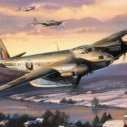

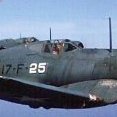

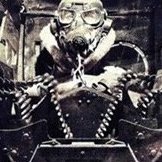
_5.56mm_Rifle_MOD_45162138.thumb.jpg.053e4f85b299efc3857bfa5c1911dc3c.jpg)



